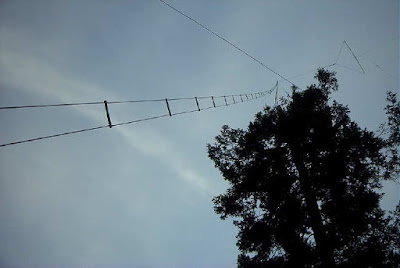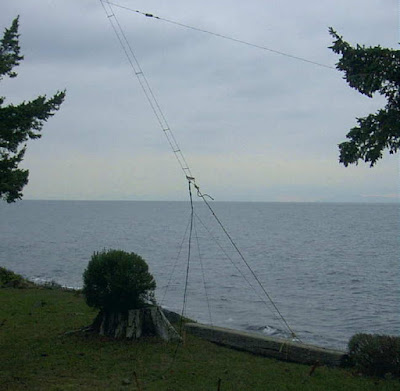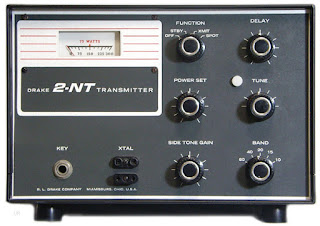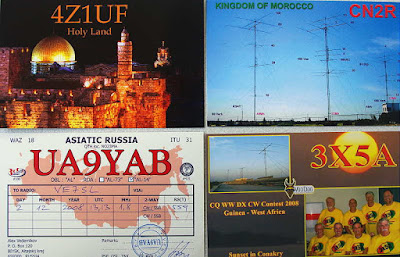Posts Tagged ‘Propagation’
 CLE 218 Results
CLE 218 Results
 |
| courtesy: https://sdo.gsfc.nasa.gov/ |
The 'Co-ordinated Listening Event' might more aptly be called the 'Cursed Listening Event' as once again the same large coronal hole (shown above) that has been present for several solar rotations seems to be more disruptive than ever. The subsequent higher than normal solar wind speeds causing widespread auroral conditions and elevated K indices have pretty much made a mess of MF and HF radio for the past several days.
 |
| courtesy: http://www.noaa.gov/ |
NDB-band recordings made with the Perseus SDR for the three-night event turned up very little activity other than a few strange hot-spots. Both 'OIN' in Kansas and 'CC' in California were strong on all three nights! Nothing from eastern Canada was heard and one of Alaska's strongest signals, 'ELF', was barely detected. Only the following few stations were logged:
23 08:00 341.0 ELF Cold Bay, ALS
22 06:00 338.0 ZU Whitecourt, AB, CAN
22 06:00 343.0 YZH Slave Lake, AB, CAN
22 04:00 344.0 YC Calgary, AB, CAN
22 12:00 338.0 RYN Tucson, AZ, USA
22 04:00 344.0 XX Abbotsford, BC, CAN
22 12:00 335.0 CC Concord, CA, USA
22 10:00 344.0 FCH Fresno, CA, USA
22 08:00 341.0 OIN Oberlin, KS, USA
22 04:00 344.0 BKU Baker, MT, USA
24 08:00 335.0 BK Brookings, SD, USA
22 04:00 347.0 PA Prince Albert, SK, CAN
22 08:00 338.0 K Port Angeles, WA, USA
22 04:00 348.0 MNC Shelton, WA, USA
22 05:00 341.0 DB Burwash, YT, CAN
I suspect the this same coronal hole will be with us for several more rotations ... perhaps it's time fool Ol' Sol and stagger our CLE's 28-day cycle so it doesn't continue go sync-up with poor band conditions but somehow I think that Murphy might not be so easily duped!
 CLE 218 Results
CLE 218 Results
 |
| courtesy: https://sdo.gsfc.nasa.gov/ |
The 'Co-ordinated Listening Event' might more aptly be called the 'Cursed Listening Event' as once again the same large coronal hole (shown above) that has been present for several solar rotations seems to be more disruptive than ever. The subsequent higher than normal solar wind speeds causing widespread auroral conditions and elevated K indices have pretty much made a mess of MF and HF radio for the past several days.
 |
| courtesy: http://www.noaa.gov/ |
NDB-band recordings made with the Perseus SDR for the three-night event turned up very little activity other than a few strange hot-spots. Both 'OIN' in Kansas and 'CC' in California were strong on all three nights! Nothing from eastern Canada was heard and one of Alaska's strongest signals, 'ELF', was barely detected. Only the following few stations were logged:
23 08:00 341.0 ELF Cold Bay, ALS
22 06:00 338.0 ZU Whitecourt, AB, CAN
22 06:00 343.0 YZH Slave Lake, AB, CAN
22 04:00 344.0 YC Calgary, AB, CAN
22 12:00 338.0 RYN Tucson, AZ, USA
22 04:00 344.0 XX Abbotsford, BC, CAN
22 12:00 335.0 CC Concord, CA, USA
22 10:00 344.0 FCH Fresno, CA, USA
22 08:00 341.0 OIN Oberlin, KS, USA
22 04:00 344.0 BKU Baker, MT, USA
24 08:00 335.0 BK Brookings, SD, USA
22 04:00 347.0 PA Prince Albert, SK, CAN
22 08:00 338.0 K Port Angeles, WA, USA
22 04:00 348.0 MNC Shelton, WA, USA
22 05:00 341.0 DB Burwash, YT, CAN
I suspect the this same coronal hole will be with us for several more rotations ... perhaps it's time fool Ol' Sol and stagger our CLE's 28-day cycle so it doesn't continue go sync-up with poor band conditions but somehow I think that Murphy might not be so easily duped!
 Another Blast Coming
Another Blast Coming
 |
| courtesy: https://sdo.gsfc.nasa.gov/ |
Speaking of 'everlasting', wimpy Solar Cycle 24 has been showing more energy in its death throws than it ever seemed to show during its peak.
It continues to blast earth with a never-ending series of coronal hole streams leading to periods of high signal absorption (particularly on the lower frequencies) and widespread auroras.
The present rip in the Sun's surface is the same one that caused major disruptions during the last solar rotation. Geomagnetic storming and propagation disruptions are forecast to begin around the 28th, with a proviso ... these ones could be even worse than last time as the wind's polarity at present is favorable to greater coupling with the Earth's magnetosphere, sending the Earth's Bz southward (negative) into auroral producing, prop-killing conditions.
Sometimes, though not normally, these events can produce periods of enhanced low frequency propagation, especially during the hours just before the event's commencement ... the best thing to do is just continue to operate normally and not assume the worst. I've been guilty of this in the past and being caught off guard, have missed some better than usual LF propagation.
I'll keep my fingers crossed over the next few days and think positive ... Bz-wise!
 Another Blast Coming
Another Blast Coming
 |
| courtesy: https://sdo.gsfc.nasa.gov/ |
Speaking of 'everlasting', wimpy Solar Cycle 24 has been showing more energy in its death throws than it ever seemed to show during its peak.
It continues to blast earth with a never-ending series of coronal hole streams leading to periods of high signal absorption (particularly on the lower frequencies) and widespread auroras.
The present rip in the Sun's surface is the same one that caused major disruptions during the last solar rotation. Geomagnetic storming and propagation disruptions are forecast to begin around the 28th, with a proviso ... these ones could be even worse than last time as the wind's polarity at present is favorable to greater coupling with the Earth's magnetosphere, sending the Earth's Bz southward (negative) into auroral producing, prop-killing conditions.
Sometimes, though not normally, these events can produce periods of enhanced low frequency propagation, especially during the hours just before the event's commencement ... the best thing to do is just continue to operate normally and not assume the worst. I've been guilty of this in the past and being caught off guard, have missed some better than usual LF propagation.
I'll keep my fingers crossed over the next few days and think positive ... Bz-wise!
 Novice Rig Round-Up Report
Novice Rig Round-Up Report

Last week's Novice Rig Round-Up delivered far more enjoyment than I ever imagined!
Operating from the left coast and choosing to limit my output power to 5 watts, I really didn't expect to work more than a half dozen stations or so. The week-long event included two weekends, providing plenty of opportunity for participants to spark-up their novice-class rigs or their favorite pre-80's 'boatanchors' ... and they did!
I had 68 contacts with other 'NRR' stations, working numerous Heathkits, Drakes, Johnsons and homebrewed favorites ... even a Collins KWS-1! Staying true to the 'novice' class spirit, most were using hand keys and a surprising number were even using crystal control.
I decided to enter the fray with my homebrew "Longfeller", shown above, run at 5W to take advantage of the low power multiplier as well as using crystal control.
After struggling to work two stations, I soon decided that if I was going to work much at all, I would need to switch to 'search and pounce' mode and use the VFO. The once ubiquitous Heathkit VF-1, with all of its charming quirks, was pressed into service. Although I've always loved its green hypnotic dial, a week with the VF-1 reminded me of all the things I also hated about it as a teenaged ham back in the mid 60s'. But as it did back then, it served me well and allowed me to park the Longfeller wherever I wanted.
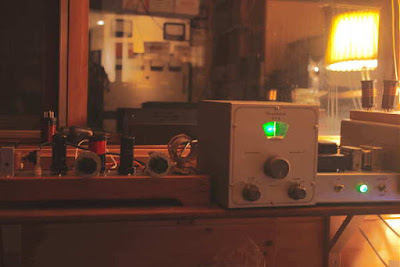 |
| My NRR Setup |
For the low bands (80/40m), the Longfeller was fed into full-sized vertical wire groundplanes made from homebrew ladder line and both fed with the same coaxial feedline.
A counterpoise of eight wire radials were laid on the lawn temporarily with the feedpoint sitting about 20' from the ocean. Being right at the ocean allows me to take advantage of an approximate 6db of "sea gain", effectively turning my 5 watts into 20 watts of radiated power. At times, my signal needed all the help it could get.
It was also exciting to catch the sometimes fleeting transcontinental openings on 15m, as the MUF often struggled to reach 21 MHz each morning. This very much reminded me of past solar cycle peak winters and the morning excitement of watching the MUF slowly climb towards 50MHz, or in some cases, shoot up like a rocket. As Cycle 24 reaches the bottom, the effects of low solar flux values on our higher bands becomes increasingly more evident. I suspect that there will be no 15m transcontinental work in next winter's NRR and who knows how long that might be the case. High MUFs were fun while they lasted ... another thing often taken for granted.
Without question, one of the most interesting parts of the nine day event was following the propagation variances from night to night on 40 and 80m. With a couple of exceptions, low-band propagation was generally pretty good, with one mid-week night being just great. Signals from the east coast to the southern states were strong and with almost no QSB. The Longfeller pushed its 80m signal to Florida, Maryland, New York, Alabama, Louisiana, Ohio and Kentucky. I remember many nights like this when operating 80m back in the early to mid 60's, during the lull between monster Cycle 19 and wimpy Cycle 20. Hopefully we will see more of these really nice transcontinental nights on 80 over the next several years.
For me however, the highlight of the event occurred last Saturday afternoon, while on 40m, fully ninety minutes before our local sunset. I had called WW6D after his 589 CQ only to hear him respond to another NRR local, Mark, CF7MM. He gave Mark's 50 watt DX-60 a '589' and when he finished I called him again ... with not even a whisper of response or even a QRZ. After I called him a third time, he returned to his CQ, leaving no doubt that he wasn't hearing a trace of my signal. Now full-sized 1/4 wave groundplanes mounted beside the ocean are not noted for producing high-angled radiation, which this path would certainly have benefited from, but I would have expected something!
I immediately moved down the band a few kilohertz and sent a short hand-keyed CQ and received an immediate response from WS1K in Plymouth, MA! Jon's signal was a solid and unwavering 559 and he was running only 5 watts as well ... and, he was crystal-controlled! The groundplane had swiftly redeemed itself as this exciting contact went into the log on 40m ... and all in broad daylight! Pictured below is Jon's transcon ether-busting machine ... proof that form does indeed follow function!
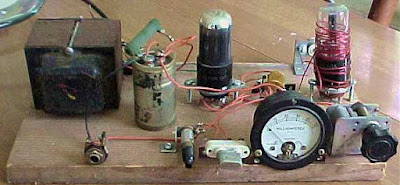 |
| WS1K's 40m Transcon 6V6 Ether-Buster |
I'm really looking forward to next year's NRR but will definitely be running more power. I was impressed with the several Drake 2NT's that I heard and luckily enough, have one such rig in my boatanchor basement. It will be a good project to recap and put back on the air, along with the VF-1, which will also be given the once over to encourage it to behave properly when driving the classy Drake.
Please give the NRR some serious thought for next year ... it's not too early to start planning, refurbishing or to seek out and cherish that aging old beauty, presently hiding in someones attic gathering dust. See you in the NRR!
 Novice Rig Round-Up Report
Novice Rig Round-Up Report

Last week's Novice Rig Round-Up delivered far more enjoyment than I ever imagined!
Operating from the left coast and choosing to limit my output power to 5 watts, I really didn't expect to work more than a half dozen stations or so. The week-long event included two weekends, providing plenty of opportunity for participants to spark-up their novice-class rigs or their favorite pre-80's 'boatanchors' ... and they did!
I had 68 contacts with other 'NRR' stations, working numerous Heathkits, Drakes, Johnsons and homebrewed favorites ... even a Collins KWS-1! Staying true to the 'novice' class spirit, most were using hand keys and a surprising number were even using crystal control.
I decided to enter the fray with my homebrew "Longfeller", shown above, run at 5W to take advantage of the low power multiplier as well as using crystal control.
After struggling to work two stations, I soon decided that if I was going to work much at all, I would need to switch to 'search and pounce' mode and use the VFO. The once ubiquitous Heathkit VF-1, with all of its charming quirks, was pressed into service. Although I've always loved its green hypnotic dial, a week with the VF-1 reminded me of all the things I also hated about it as a teenaged ham back in the mid 60s'. But as it did back then, it served me well and allowed me to park the Longfeller wherever I wanted.
 |
| My NRR Setup |
For the low bands (80/40m), the Longfeller was fed into full-sized vertical wire groundplanes made from homebrew ladder line and both fed with the same coaxial feedline.
A counterpoise of eight wire radials were laid on the lawn temporarily with the feedpoint sitting about 20' from the ocean. Being right at the ocean allows me to take advantage of an approximate 6db of "sea gain", effectively turning my 5 watts into 20 watts of radiated power. At times, my signal needed all the help it could get.
It was also exciting to catch the sometimes fleeting transcontinental openings on 15m, as the MUF often struggled to reach 21 MHz each morning. This very much reminded me of past solar cycle peak winters and the morning excitement of watching the MUF slowly climb towards 50MHz, or in some cases, shoot up like a rocket. As Cycle 24 reaches the bottom, the effects of low solar flux values on our higher bands becomes increasingly more evident. I suspect that there will be no 15m transcontinental work in next winter's NRR and who knows how long that might be the case. High MUFs were fun while they lasted ... another thing often taken for granted.
Without question, one of the most interesting parts of the nine day event was following the propagation variances from night to night on 40 and 80m. With a couple of exceptions, low-band propagation was generally pretty good, with one mid-week night being just great. Signals from the east coast to the southern states were strong and with almost no QSB. The Longfeller pushed its 80m signal to Florida, Maryland, New York, Alabama, Louisiana, Ohio and Kentucky. I remember many nights like this when operating 80m back in the early to mid 60's, during the lull between monster Cycle 19 and wimpy Cycle 20. Hopefully we will see more of these really nice transcontinental nights on 80 over the next several years.
For me however, the highlight of the event occurred last Saturday afternoon, while on 40m, fully ninety minutes before our local sunset. I had called WW6D after his 589 CQ only to hear him respond to another NRR local, Mark, CF7MM. He gave Mark's 50 watt DX-60 a '589' and when he finished I called him again ... with not even a whisper of response or even a QRZ. After I called him a third time, he returned to his CQ, leaving no doubt that he wasn't hearing a trace of my signal. Now full-sized 1/4 wave groundplanes mounted beside the ocean are not noted for producing high-angled radiation, which this path would certainly have benefited from, but I would have expected something!
I immediately moved down the band a few kilohertz and sent a short hand-keyed CQ and received an immediate response from WS1K in Plymouth, MA! Jon's signal was a solid and unwavering 559 and he was running only 5 watts as well ... and, he was crystal-controlled! The groundplane had swiftly redeemed itself as this exciting contact went into the log on 40m ... and all in broad daylight! Pictured below is Jon's transcon ether-busting machine ... proof that form does indeed follow function!
 |
| WS1K's 40m Transcon 6V6 Ether-Buster |
I'm really looking forward to next year's NRR but will definitely be running more power. I was impressed with the several Drake 2NT's that I heard and luckily enough, have one such rig in my boatanchor basement. It will be a good project to recap and put back on the air, along with the VF-1, which will also be given the once over to encourage it to behave properly when driving the classy Drake.
Please give the NRR some serious thought for next year ... it's not too early to start planning, refurbishing or to seek out and cherish that aging old beauty, presently hiding in someones attic gathering dust. See you in the NRR!
 Upcoming Solar Years … Can They Be Too Quiet?
Upcoming Solar Years … Can They Be Too Quiet?

Most of us LF/MF and topband diehards have been looking forward to the next several years of low solar activity ... maybe even 'ultra-low' as some of the solar gurus are predicting.
An interesting posting on the Topband reflector a few weeks ago by noted propagation expert, Carl, K9LA, made me re-think my expectations!
I flagged the post for a later blog topic but have since seen the information pop-up on a couple of other reflectors as well as on the ARRL News page. Apparently I wasn't the only one to give the posting a double-take. If you missed it, here is Carl's post:
About a week ago Wolf DF2PY posted a message here commenting on the recent adverse levels of geomagnetic field activity and how it will now change for the good - giving us good 160m propagation.
We'll certainly see less geomagnetic field activity as we move into winter,
but there's another issue we should be aware of. The Sun's magnetic field
is weakening - probably to the lowest levels in our lifetime. With a weak
solar magnetic field, more galactic cosmic rays will be able to get into
the Earth's atmosphere. We are now seeing unprecedented high neutron counts (neutrons are one of the by-products of cosmic rays)
Since galactic cosmic rays are mostly *very energetic* protons, they can
get down to low atmospheric altitudes, causing collisional ionization in
the D region (and lower E region). A cursory estimate using cosmic ray
ionization rates confirms more ionization in the lower atmosphere. 160m is
not very tolerant of more absorption, so we may see an adverse effect of
the weakened solar magnetic field.
Many of us think that "solar min is solar min is solar min". But maybe a
solar minimum can be too deep for 160m. A good question to ask in the early 2020s will be "how was 160m?" So stay active on 160m and let's see what happens.
Carl K9LA
My initial response was to think that perhaps there wouldn't be as much to look forward to as I had been hoping for, when it came to improved LF, MF and 160m propagation. Carl's postulation was also backed-up by another mention on the Spaceweather site, although the influence of cosmic ray bombardment on radio propagation was not discussed.
As I thought more about this unfortunate possibility actually coming to pass, I thought back to my own on-air and listening experiences during previous solar-low years ... particularly the unprecedented low between our most recent cycle and its predecessor, Cycle 23.
The low period between these two cycles, as most will likely recall, saw the quietest solar conditions observed in the past 100 years. The solar-low winters saw week after week of a blank Sun, with solar activity virtually flatlining for the entire period. In 2008 there were 265 'zero sunspot' days and the following year saw another 262 days of blank suns!
These effects were well noted here for two winters that are usually prime 'DX times' ... if ever there were a period when cosmic ray bombardment should negatively impact low frequency propagation, surely it would have been then.
So just what did I observe?
What I saw was not only what I had been expecting but was much much better than I had ever believed possible. For west coast topband operators, the 'holy grail' of propagation is working Europe. Working Europe from here means that signals must travel through the polar regions, usually the kiss-of- death for weak signals, as the severe attenuation through the auroral zone means that it just doesn't happen very often ... except for this prolonged period of ultra lows. In a word, conditions to Europe were 'spectacular' ... night-after-night, for several weeks over a period of two winters, working Europe on 160 became normal.
On most nights, European signals could be heard before local sunset, and on several occasions, CW contacts with Europeans, were completed up to one and a half hours before my local sunset. As darkness set in, more signals would appear and the band would rapidly become populated with Europeans ... and only Europeans.
Most of the time there were no signals from North America evident, just Europeans ... a condition that had me shaking my head in disbelief night after night. It was something I had never observed before, as I watched 160m behaving more like 20m CW on a good day to Europe! During this period, my DXCC totals skyrocketed from 99 to 143 worked, as new Europeans and Africans were added to my logbook.
Signal levels were also outstanding, often pushing the FT-1000 S-meter well past the S9 level. On one particular night, I recall hearing an SM4 calling CQ, with just such a signal. I set my output power level at 10 watts and gave him a call, to which he quickly responded. If cosmic ray bombardment was at a high level, it was not reeking any havoc as far as the west coast path to Europe was concerned! For the record, my topband system is nothing special, consisting of a simple 'half-sloper' over a poor ground and a very old amplifier running about 500W output.
My other favorite winter pastime is chasing NDBs in the MF range between 200-500 kHz. Exceptional east west conditions were evident throughout the two winters of ultra-lows.
On one such night, I noted a new strong signal where none had been previously heard. Because of its strength, I surmised that it was probably a new NDB in nearby Washington state. Noting its ident ('NYA' on 414 kHz), I was not able to find any reference to such a beacon being previously reported and turned to the Yahoo ndblist group for help, posting my catch as 'unidentified'. Almost immediately I received a response, telling me that the signal I was hearing was located in Europe ... Svalbard to be exact, located midway between Norway and the North Pole!
Now, European NDBs have never been heard from the west coast, other than occasional signals from some of Greenland's powerhouses, so this represents a very rare event. Although I have often listened for this signal, it has yet to be heard here again and my logging of remains its only reported foray into any part of North America. Unfortunately, in 2015, it was listed as 'decomissioned'. I have no doubts that this rare propagation was a result of the solar flatlining conditions of the time.
As chilling as Carl's warning sounds, he himself admits uncertainty with a 'let's wait and see' attitude and after reviewing my own experiences under what surely must be similar conditions, I'm still very optimistic over what might be in store. Hopefully we shouldn't have to wait too much longer to find out!
